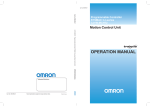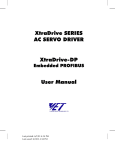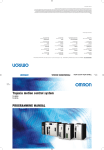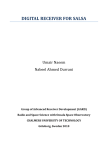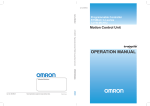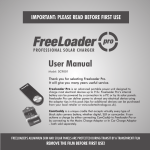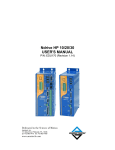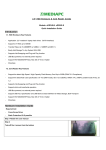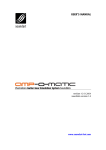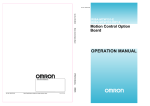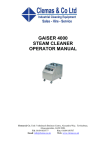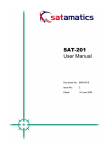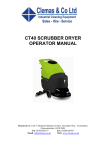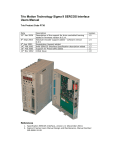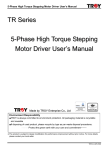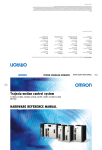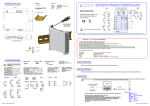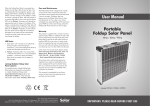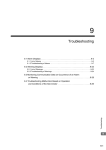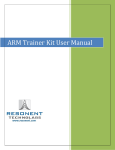Download TN20_63 SERCOS Registration and Homing(1)
Transcript
www.triomotion.com Doc No.: Version: Date: Subject: Trio Motion Technology Ltd. Shannon Way, Tewkesbury, Gloucestershire. GL20 8ND United Kingdom Tel: +44 (0)1684 292333 Fax: +44 (0)1684 297929 1000 Gamma Drive Suite 206 Pittsburgh, PA 15238 United States of America Ph: +1 412.968.9744 Fx: +1 412.968.9746 TN20-63 1.0 3rd February 2004 SERCOS Registration and Homing Application Information Contents: Contents:..................................................................................................................... 1 References: ................................................................................................................ 1 Acronyms:................................................................................................................... 1 Introduction:.............................................................................................................. 1 Rockwell ‘Kinetix and Ultra Drives’ – Homing : ........................................... 2 Rockwell ‘Kinetix and Ultra Drives’ – Registration :................................... 4 Sanyodenki Drives (PVSercos): ......................................................................... 6 Yaskawa Drives: ....................................................................................................... 7 References: 1 : SigmaII User’s Manual Design and Maintenance (Manual No. SIE-S800-32.2) Acronyms: RTS : RTC : Real Time Status bit (flag in the drive telegram status word). Real Time Control bit (flag in the master telegram control word). Introduction: This application note describes how to perform registration and homing procedures over a SERCOS ring when using a Trio Controller master and the slave drives of several different manufacturers. SERCOS Interface Commands from Trio BASIC Page 1 of 12 TN20_53 Issue 1.0 09/09/04 Rockwell ‘Kinetix and Ultra Drives’ – Homing : Rockwell drives support the SERCOS ‘control unit controlled homing procedure command’. The drive latches the z-mark, which the SERCOS master uses to determine the required move to the home position. The TrioBASIC ‘regist/mark/reg_pos’ keywords are used to perform the homing procedure, along with several ‘sercos<>’ commands which are required to initialise the drive. The example program below illustrates this procedure. The drive will latch the encoder value (the z-mark) in the ‘Marker Position A’ (IDN 00173) after a homing procedure command has been started (IDN 00146) and both the home enable (zmark, IDN 00407) and home switch (if necessary, IDN 00400) have been triggered. The control unit must then move the drive based on this latched position to the required home position. If Bit 5 of the homing parameter (IDN 00147) is set – meaning do not evaluate the home switch – the drive is homed on the z-mark. If Bit 5 is cleared – meaning evaluate the home switch – the drive is homed on the z-mark only after the home switch has been set. Although the SERCOS specification defines various homing configuration parameters in the ‘Homing Parameter’ (IDN 00147), the Kinetix drives tested in the Trio lab would only latch the encoder value on the z-mark. It could not be configured to latch the encoder value on the home-switch. The drive telegram’s Real Time Status bit 1 (RTS1) reflects the state of the marker pulse – hence the value 408 (the ‘Reference Marker Pulse Registered’ SERCOS parameter is IDN 00408) is written to IDN 00305 (The Allocation of Real Time Status Bit 1). The master telegram’s Real Time Control bit 1 (RTC1) determines whether homing is enabled – hence value 407 (the Homing enable is SERCOS parameter IDN 00407) is written to IDN 00301 (the Allocation of Real Time Control bit 1.) Example Homing program: nslot=0 ndrive=81 ndriveaxis=7 datum_speed=0.25 home_switch = 0 ' PRINT"Homing Drive ..." 'Initialise SERCOS(5,nslot,ndrive,408,2,0) ‘Reference Marker Pulse Registered ‘Reference Marker Pulse Registered connected to RTS1 SERCOS(5,nslot,ndrive,305,2,408) SERCOS Interface Commands from Trio BASIC Page 2 of 12 TN20_53 Issue 1.0 09/09/04 'Homing parameter IF home_switch THEN 'Drive evaluates homing switch & enable, and homes to z-mark AFTER switch has 'been seen. '(IDN 174 will latch encoder value when home switch triggered) SERCOS(5,nslot,ndrive,147,2,$04) ELSE 'Drive homes to z-mark. SERCOS(5,nslot,ndrive,147,2,$34) ENDIF 'Homing enable (407) connected to RTC1 SERCOS(5,nslot,ndrive,301,2,407) 'Homing procedure command 'Start homing in drive. SERCOS(6,nslot,ndrive,146,10000,1) BASE(ndriveaxis) old_speed=SPEED SPEED=datum_speed REGIST(1) 'Move until mark seen. FORWARD WHILE NOT MARK WEND CANCEL WAIT IDLE DEFPOS(0) 'Marker Position A now contains latched z-mark position. SPEED=old_speed 'end homing in drive. SERCOS(6,nslot,ndrive,146,10000,0) PRINT"Homing procedure completed" SERCOS Interface Commands from Trio BASIC Page 3 of 12 TN20_53 Issue 1.0 09/09/04 Rockwell ‘Kinetix and Ultra Drives’ – Registration : Rockwell drives support the SERCOS probe procedure command, which is used with the TrioBASIC ‘regist/mark/reg_pos’ commands to perform registration. Please see the Yaskawa Section for a detailed discussion of the SERCOS parameters used. Example Program: '********************************************* ' AB Kinetix Datum ' program constants high = 0 low = 1 'Program data nslot=0 ndrive=81 ndriveaxis=7 datum_speed=0.25 'Trig Config trig_edge = high 'Begin 'RTC1 to update IDN 405 (Probe 1 enable/disable) '(Hence controller regist function controls SERCOS probe enable/disable (IDN405)) SERCOS(5,nslot,ndrive,301,2,405) ' IDN 305 : RTS Bit 1 : to trigger on probe 1 latch - either high (409: probe ' 1 positive latched) or low (410: probe 1 negative latched) status. ' IDN 169 : Probe Control Parameter - Set active edge which determines which ' idn the recorded probe value will be stored in (either 130 high or 131 low). IF trig_edge = high THEN SERCOS(5,nslot,ndrive,305,2,409) SERCOS(5,nslot,ndrive,169,2,1) 'ensure idn 130 is in AT telegram. ELSE SERCOS(5,nslot,ndrive,305,2,410) SERCOS(5,nslot,ndrive,169,2,2) 'ensure idn 131 is in AT telegram. ENDIF 'Initialise registration BASE(ndriveaxis) old_speed=SPEED SPEED=datum_speed REGIST(1) 'Move until mark seen. SERCOS Interface Commands from Trio BASIC Page 4 of 12 TN20_53 Issue 1.0 09/09/04 FORWARD WHILE NOT MARK WEND CANCEL WAIT IDLE 'Move back to datum position. MOVEABS(REG_POS) WAIT IDLE SPEED=old_speed SERCOS Interface Commands from Trio BASIC Page 5 of 12 TN20_53 Issue 1.0 09/09/04 Sanyodenki Drives (PVSercos): The following program illustrates how to datum a SERCOS axis to the motor Z-mark, using the ‘drive controlled homing procedure command’. It is also possible to datum to a homing switch, or the master can control the homing procedure (see the drive ‘Installation and Operation’ manual for details.) '********************************************* 'Datum sequence BASE(naxis) SERVO=OFF WA(500) 'Run homing procedure command – home on z-mark. SERCOS(6,nslot,ndrive1,148,8000,1) WA(500) 'Cancel homing procedure command SERCOS(6,nslot,ndrive1,148,8000,-1) SERVO=ON WA(200) ‘Now move from z-mark to home position. MOVE(-0.037) WAIT IDLE DEFPOS(0) SERCOS Interface Commands from Trio BASIC Page 6 of 12 TN20_53 Issue 1.0 09/09/04 Yaskawa Drives: High speed registration is performed by the SigmaII drive. Registration is achieved using the TrioBASIC ‘mark/regist/reg_pos’ keywords on the z-mark or an external input. However, before this is possible certain drive parameters have had to be initialised and the SERCOS telegrams configured appropriately. The three example programs below illustrate how the drive can be configured to perform registration on the encoder z-mark. 1. Registration Initialisation: The drive parameter Pn511 is configured to assign a CN1 input to the EXT1/EXT2/EXT3 channel. Parameter Pn511 Digit Place 0 Name Setting Description Default /DEC 0 to F 8 1 /EXT1 0 to F 2 /EXT2 0 to F 3 /EXT3 0 to F /DEC origin search signal mapping 8: Disabled 4: Assigned to SI4, active high. 8: Disabled 5: Assigned to SI5, active high. 8: Disabled 6: Assigned to S16, active low (falling edge). F: Assigned to SI6, active high (rising edge). 8: Disabled 8 8 8 The Input Signal Allocation (parameters Pn50A and Pn50B) are configured as appropriate ( see Ref 1 ), and the power cycled to the drive before these changes are effective. Parameter Pn50A Digit Place 0 1 Name Setting Description Default I/O Signal Allocation Mode /S-ON 0 1: Signals may be assigned freely. 0:input signal allocation as per servo amplifier sequence. 0 0 1 2 3 4 5 6 7 8 9 A Inputs from the SI0 (CN1-40) input Inputs from the SI1 (CN1-41) input Inputs from the SI2 (CN1-42) input Inputs from the SI3 (CN1-43) input Inputs from the SI4 (CN1-44) input Inputs from the SI5 (CN1-45) input Inputs from the SI6 (CN1-46) input Sets signal ON Sets signal OFF Inputs the reverse signal from SI0 Inputs the reverse signal from SI1 0: SI0 SERCOS Interface Commands from Trio BASIC Page 7 of 12 TN20_53 Issue 1.0 09/09/04 terminal terminal terminal terminal terminal terminal terminal Parameter Pn50B 2 3 /P-CON P-OT B C D E F 0 to F 0 to F Digit Place 0 1 2 3 Name Setting Description Default N-OT /ALM-RST /P-CL /N-CL 0 0 0 0 As As As As 3: 4: 5: 6: to to to to F F F F Inputs the Inputs the Inputs the Inputs the Inputs the As above As above reverse reverse reverse reverse reverse signal signal signal signal signal from from from from from SI2 SI3 SI4 SI5 SI6 above above above above 1: SI1 2: SI2 SI3 SI4 SI5 SI6 The example registration initialisation program below illustrates how to configure these parameters for registration on the z-mark or external inputs. This program need only be run once ( and then the drive power cycled to enable the parameter values ) since the parameters are stored in EEPROM in the drive. Initialisation Example Program: ' Initialise Drive ready for registration. ' NB - power to drive must be cycled after setting these values. ' program constants high = 0 low = 1 nslot=0 ndrive=1 'Required trigger mode and signal edge. 'Trig mode - 0:origin(Z)mark,1:ext1,2:ext2,3:ext3 trig_mode = 0 trig_edge = high 'Z-mark registration IF trig_mode = 0 THEN SERCOS(5,nslot,ndrive,32768+$511,2,$8888) SERCOS(5,nslot,ndrive,32768+$50A,2,$8100)' Pn50A Input Selections 1 SERCOS(5,nslot,ndrive,32768+$50B,2,$6548)' Pn50B Input Selections 2 ELSE SERCOS(5,nslot,ndrive,32768+$50A,2,$8881)' Pn50A Input Selections 1 SERCOS Interface Commands from Trio BASIC Page 8 of 12 TN20_53 Issue 1.0 09/09/04 SERCOS(5,nslot,ndrive,32768+$50B,2,$8888)' Pn50B Input Selections 2 'External input 1 IF trig_mode=1 THEN IF trig_edge = high THEN 'Active high - rising edge. SERCOS(5,nslot,ndrive,32768+$511,2,$88F8) ELSE 'Active low - falling edge. SERCOS(5,nslot,ndrive,32768+$511,2,$8848) ENDIF 'External input 2 ELSEIF trig_mode=2 THEN IF trig_edge = high THEN 'Active high - rising edge. SERCOS(5,nslot,ndrive,32768+$511,2,$8F88) ELSE 'Active low - falling edge. SERCOS(5,nslot,ndrive,32768+$511,2,$8588) ENDIF 'External input 3 ELSEIF trig_mode= 3 THEN IF trig_edge = high THEN 'Active high - rising edge. SERCOS(5,nslot,ndrive,32768+$511,2,$F888) ELSE 'Active low - falling edge. SERCOS(5,nslot,ndrive,32768+$511,2,$6888) ENDIF ELSE 'Error ENDIF ENDIF 2. SERCOS Telegram Configuration : For the TrioBASIC ‘mark/regist/reg_pos’ keywords to work with SERCOS it is necessary to configure the SERCOS network telegrams to include the latched value in the drive telegram (AT), and to set an appropriate axis ‘atype’. The AT is set as an ‘application’ telegram enabling the contents to be user defined. The first parameter in this telegram must be the position feedback, and the second is the positive or negative latched value as required. Active high (positive edge) latched values are written to SERCOS parameter IDN 00130, and active low (negative edge) latched values to IDN 00131 by the drive. The axis atype will depend upon the drive control mode. SERCOS Interface Commands from Trio BASIC Page 9 of 12 TN20_53 Issue 1.0 09/09/04 AType 22 23 Control Mode Velocity Position AT Telegram Contents Position and latched value Position and latched value SERCOS initialisation program snippet – slave drive configured in velocity control mode with positive latched registration: SERCOS(5,nslot,ndrive1,15,2,7)'IDN 00015 – application telegrams. SERCOS(5,nslot,ndrive1,32,2,2)'IDN 00032 Velocity control mode. SERCOS(5,nslot,ndrive1,16,6,51,130) 'drive telegram - position & positive latch values. SERCOS(5,nslot,ndrive1,24,6,36) 'master telegram - velocity command. SERCOS initialisation program snippet – slave drive configured in velocity control mode with positive latched registration: ATYPE AXIS(drive1axis)=22 'velocity+latch position 3. Example drive registration program : Registration shall be possible after having configured the drive parameters and SERCOS telegrams, brought the SERCOS ring into communications phase 4 (normal operations), and setup the SERCOS axis on the Trio controller. The SERCOS Real Time Control (RTC) and Real Time Status (RTS) bits within the master and drive telegrams are configured to enable/disable registration and to provide latch status feedback respectively. The drive is informed of the registration mode via IDNs 00169 (Probe Control Parameter) and the product specific P-IDN 49252. SERCOS IDN 00301 Name Allocation of Real Time Control Bit 1 00305 Allocation of Real Time Status Bit 1 00169 Probe Control Parameter 49252 Probe Latch Input Notes 405 : (IDN 00405 = Probe 1 Enable). Hence RTC1 controls registration enable/disable. 409: (IDN 00409 = Probe 1 positive latched), or 410: (IDN 00410 = Probe 1 negative latched). Hence, RTS1 reflects status of latch. 1: Positive edge is latched. 2: Negative edge is latched. 0: z-mark, 1: EXT1, 2: EXT2, 3: EXT3 The Regist command initialises the registration mode on the drive at run time. After the regist mark has been seen, the ‘mark’ flag will be set and reg_pos will contain the latched regist position. SERCOS Interface Commands from Trio BASIC Page 10 of 12 TN20_53 Issue 1.0 09/09/04 '************************************************************************ 'P730 Regist/datum Support ' ' ' ' ' ' ' ' ' Notes 1. must have initialised drive parameters (Pn511, Pn50A & Pn50B) and cycled power to the drive before running this program. 2. Active High (positive edge)latch requires IDN 00130 in cyclic data telegram, (configured in main startup program) and IDN 00305=409 & IDN 00169=1 (configured below) 3. Active low (negative edge ) latch requires IDN 00131 in telegram, and IDN 00305=410 & IDN 00169=2 4. you must be running in VELOCITY/POSITION and REG telegram mode !! ' program constants high = 0 low = 1 'Program data nslot=0 ndrive=1 ndriveaxis=6 'Trig mode ' 0 = origin(Z)mark,1=ext1,2=ext2,3=ext3 trig_mode = 0 trig_edge = high 'Begin 'RTC1 to update IDN 405 (Probe 1 enable/disable) '(Hence controller regist function controls SERCOS probe enable/disable (IDN405)) SERCOS(5,nslot,ndrive,301,2,405) ' IDN 305 : RTS Bit 1 : to trigger on probe 1 latch - either high (409: probe ' 1 positive latched) or low (410: probe 1 negative latched) status. ' IDN 169 : Probe Control Parameter - Set active edge which determines which ' idn the recorded probe value will be stored in (either 130 high or 131 low). IF trig_edge = high THEN SERCOS(5,nslot,ndrive,305,2,409) SERCOS(5,nslot,ndrive,169,2,1) 'ensure idn 130 is in AT telegram. ELSE SERCOS(5,nslot,ndrive,305,2,410) SERCOS(5,nslot,ndrive,169,2,2) 'ensure idn 131 is in AT telegram. ENDIF 'Configure drive latch input (using a P-IDN). SERCOS(5,nslot,ndrive,49252,2,trig_mode) 'Initialise registration BASE(ndriveaxis) SERCOS Interface Commands from Trio BASIC Page 11 of 12 TN20_53 Issue 1.0 09/09/04 old_speed=SPEED SPEED=1 REGIST(1) 'Move until mark seen. FORWARD WHILE NOT MARK WEND CANCEL WAIT IDLE 'Move back to datum position. MOVEABS(REG_POS-0.09) WAIT IDLE DEFPOS(0) SPEED=old_speed SERCOS Interface Commands from Trio BASIC Page 12 of 12 TN20_53 Issue 1.0 09/09/04












